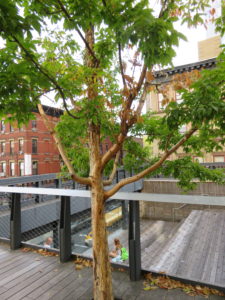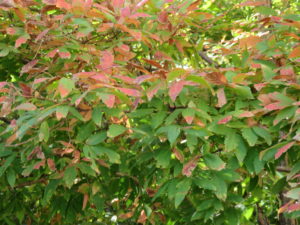Three flower maple (Acer triflorum), often called trifoliate maple, is native to eastern Asia (USDA hardiness zones 4-7). The latter pseudonym is misleading as A. triflorum is actually one of many compound-leafed maples identified as “trifoliate maples”. This small deciduous understory maple typically grows 2o-25 feet tall with a densely-branched, rounded crown. Specimens often grow to 35-40 feet in height range.
The tree’s outstanding features include its attractive shape, exfoliating tan brown bark, and fall leaf color. The young fully expanded spring leaves show off a fine pubescence. As autumn approaches, the medium green trifoliate leaves (leaflets to 3 inch long) take on vibrant shades of orange to red in autumn.
Tan brown bark exfoliates in vertical strips to reveal orange-brown inner bark. Greenish-yellow flowers appear in April in clusters of three, hence the species and common names. As with most maples, the flowers are not showy. Fruits are double winged samaras (1-1.25 inches long). Some individuals may confuse the tree with paperbark maple, Acer griseum, another beautiful trifoliate maple.
The tree grows in average, medium moist, mildly acidic (5.5-6.5 pH), well-drained soil and planted in full sun to part shade location. Keep in mind that three flowered maple is an understory species. In its southerly zone 7 range, full-day sunlight may be too harsh. Good soil fertility, moisture and drainage are keys to growing these small maple species.
A newly planted tree should be adequately irrigated the first two years after planting. Feed annually (in late winter or early spring) with a slow release fertilizer such as Osmocote® or Nutricote®. according to package directions. Maintain a 3-4 inch deep, weed-free, organic-mulched zone around the tree.
Disease and insect issues are rare if tree(s) are properly well cared for. Leaves may turn chlorotic (yellowed) if soil acidity climbs above 6.8 pH. In most years little annual pruning is necessary.



 Posted in
Posted in 
